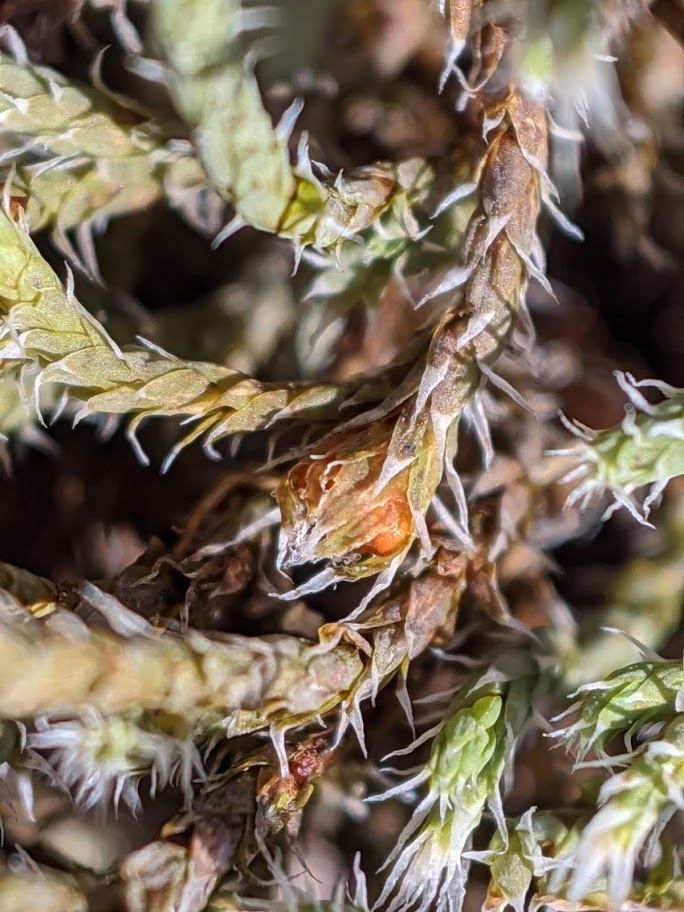Hedwigia ciliata
(Hedw.) P.Beauv.Loose mats or tufts on rocks, grey-green to olive-green. Stems to 4 cm long, red-brown, with scattered brown rhizoids. Leaves erect-spreading to spreading when moist, erect-spreading when dry, ovate to oblong-ovate, 1.4–2.2 (–3) mm long, 0.7–1.2 mm wide, concave; apex acuminate, hyaline, sometimes secund when dry; costa absent; base weakly decurrent; margins entire to lightly denticulate near apex, slightly recurved near base; laminal cells in apical half irregularly subquadrate to rectangular, 7–25 μm long, 2–10 μm wide, with 1–2 branched or simple papillae on each surface; laminal cells of hair-point strongly differentiated, linear-fusiform, white, with numerous papillae or terminal cells often smooth; basal laminal cells near middle linear, 30–150 μm long, 6–12 μm wide, orange-yellow, with a row of simple papillae, becoming subquadrate and similar to other laminal cells toward margin; alar cells quadrate, 12–35 μm long, 10–15 μm wide, smooth. Perichaetial leaves oblong, larger than stem leaves, with margins toward apex ciliate. Setae c. 0.4–1.5 mm long, yellow, smooth. Capsules ovoid, erect, c. 1 mm long. Calyptra glabrous or sparsely to densely pilose. Operculum umbonate, c. 0.5 mm long.
Wim, GleP, VVP, VRiv, OtP, WaP, Gold, CVU, GGr, DunT, NIS, EGL, EGU, WPro, HSF, HNF, MonT, HFE, VAlp. Widespread throughout the state except for the north-west, in rocky and often dry areas that are exposed or among grassland or sclerophyll woodland or forest. Also WA, SA, QLD, NSW and Tas. Currently cosmopolitan but see notes below.
This species is easily recognised among Victorian species by a combination of its loose tufted or mat growth form on dry rocks, the grey-green colour of the new growth and the conspicuous white leaf apices.
The species limits of Hedwigia ciliata requires further investigation. In phylogenetic analyses of a combined dataset of DNA sequences from regions belonging to all genomes, European populations likely to be representative of the European type were shown to be more closely related to other species of Hedwigia than they were to Australian populations currently included in H. ciliata (Buchbender et al. 2014). The Australian populations were closely related to Chilean H. ciliata populations and it has been suggested that Southern Hemisphere populations may be better recognised as a separate species, H. nivalis (Müller Hal.) Mitten (Buck & Norris 1996). Under the current circumscription H. ciliata varies with regard to the distribution, type and number of papillae on cells, which may provide important characters for distinguishing currently unrecognised species.
 Spinning
SpinningBuchbender, V.; Hespanhol, H.; Krug, M.; Sérgio, C.; Séneca, A.; Maul, K.; Hedenäs, L.; Quandt, D. (2014). Phylogenetic reconstructions of the Hedwigiaceae reveal cryptic speciation and hybridisation in Hedwigia. Bryophyte Diversity and Evolution 36.
Buck, W.R.; Norris, D.H. (1996). Hedwigia stellata and H. detonsa (Hedwigiaceae) in North America. Nova Hedwigia 62: 361–370.
Fife, A.J. (2014). Hedwigiaceae. In Heenan, P.B., Breitwieser, I., & Wilton, A.D. (eds), Flora of New Zealand — Mosses. Fascicle 14. Manaaki Whenua Press, Lincoln.
Gilmore, S.R. (2012). Australian Mosses Online 4. Hedwigiaceae. Australian Biological Resources Study, Canberra. Version 10 April 2012. http://www.anbg.gov.au/abrs/Mosses_online/04_Hedwig.html.



